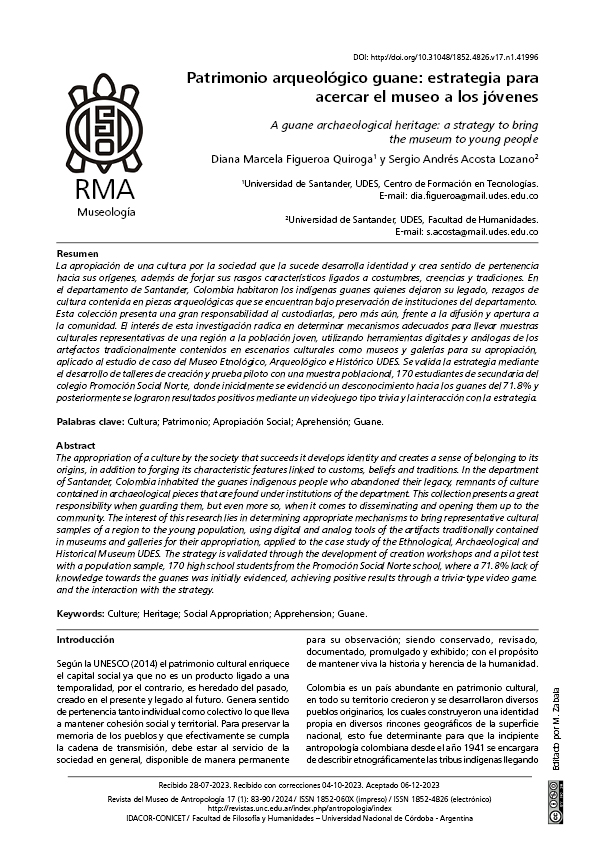A guane archaeological heritage: a strategy to bring the museum to young people
DOI:
https://doi.org/10.31048/1852.4826.v17.n1.41996Keywords:
Culture, Heritage, Social Appropriation, Apprehension, GuaneAbstract
The appropriation of a culture by the society that succeeds it develops identity and creates a sense of belonging to its origins, in addition to forging its characteristic features linked to customs, beliefs and traditions. In the department of Santander, Colombia inhabited the guanes indigenous people who abandoned their legacy, remnants of culture contained in archaeological pieces that are found under institutions of the department. This collection presents a great responsibility when guarding them, but even more so, when it comes to disseminating and opening them up to the community. The interest of this research lies in determining appropriate mechanisms to bring representative cultural samples of a region to the young population, using digital and analog tools of the artifacts traditionally contained in museums and galleries for their appropriation, applied to the case study of the Ethnological, Archaeological and Historical Museum UDES. The strategy is validated through the development of creation workshops and a pilot test with a population sample, 170 high school students from the Promoción Social Norte school, where a 71.8% lack of knowledge towards the guanes was initially evidenced, achieving positive results through a trivia-type video game. and the interaction with the strategy.
Downloads
References
Alcaldía de Bucaramanga, (s.f.). Bucaramanga. Recuperado el 2023, de Alcaldía de Bucaramanga https://www.bucaramanga.gov.co/otros/mi-ciudad/
Baudrillard, J. (1978). Cultura y simulacro. Barcelona: Kairos.
Bourdieu, P. y Darbel, A. (2003). El amor al arte: Los museos europeos y su público. Barcelona: Paidós.
Berenstein, I. y Puget, J. (1997). Lo vincular. Clínica y Técnica Psicoanalítica. Buenos Aires: Paidós.
Cáceres, L. J. (1998). Técnicas de investigación en sociedad, cultura y comunicación. México: Pearson.
Cómo vamos, (2023). Encuesta de Percepción Ciudadana 2023. Recuperado el 2023, de Bogotá Cómo Vamos: https://bogotacomovamos.org/productos/#encuesta
Cómo vamos, (2 de septiembre de 2021). Encuesta de Percepción Ciudadana BMCV - 2019. Recuperado el 2021, de Bucaramanga Metropolitana Cómo Vamos: https://www.bucaramangacomovamos.org/post/encuesta-de-percepci%C3%B3n-ciudadana-bmcv-2019
Correa, F. (2006). Interpretaciones antropológicas sobre lo «indígena» en Colombia. Universitas humanística, 62, 15-42.
Forteza, M. (2012). El papel de los museos en las redes sociales. Biblios 48, 31-40. DOI: 10.5195/biblios.2012.66.
García, M. (2010). Patrimonio y herencia cultural: ¿escenarios de divergencia? Sphera Pública, 10, 337-372.
Jenkins, H. (2003). Transmedia Storytelling. MIT Technology Review. 4. Recuperado de https://www.technologyreview.com/s/401760/transmedia-storytelling/
Latour, B. (2008). Reensamblar lo social. Una introducción a la teoría del actor-red. Buenos Aires: Manantial.
Martín-Barbero, J. (1998). De los medios a las mediaciones: comunicación, cultura y hegemonía. Razón y Palabra, 75. http://www.razonypalabra.org.mx/N/N75/monotematico_75/07_Baca_M75.pdf
Murray, J. (1999). Hamlet en la holocubierta. Barcelona: Paidós.
Rahman, A., y Fals Borda, O. (1992). La situación actual y las perspectivas de la IAP en el mundo. En S. M. (coord), La investigación-acción participativa: inicios y desarrollos (pp. 205 - 230). Editorial Popular: Organización de Estados Iberoamericanos para la Educación, la Ciencia y la Cultura: Sociedad Estatal Quinto Centenario.
Salmon, C. (2008). Storytelling. La máquina de fabricar historias y formatear las mentes. Barcelona: Atalaya.
Sánchez, I., Peris, F., y Esnaola Horacek, G. (2014). Los videojuegos en la educación. Aularia, 3(1), 21-26.
SIMCO. (5 de enero de 2016). SIMCO. Recuperado el 2018, de SIMCO Sistemas de Información de Museos Colombianos: http://simco.museoscolombianos.gov.co/Home/Simco
Scattolin, M. C., Bugliani, M. F., Domingorena, L. P., Cortés, L. I., Lazzari, M., Izeta, A. D., y Calo, C. M. (2015). Habitar, circular, hacer. El punto de vista de La Quebrada. En Crónicas materiales precolombinas: Arqueología de los primeros poblados del Noroeste Argentino, (pp. 427-464). Buenos aires: Sociedad Argentina de Antropología.
Schutter, A. d. (1980). Investigación participativa. Pátzcuaro: Crefal.
Tylor, E. B. (1975). La ciencia de la cultura. En Kahn, J. S. (Comp.), El concepto de cultura (pp. 29-46). Barcelona: Anagrama
UNESCO (2014). Indicadores UNESCO de Cultura para el Desarrollo. http://en.unesco.org/creativity/cdis
Viñaras-Abad, M y Caerols-Mateo, R. (2016). #5Museos: un caso de éxito sobre la oportunidad de las redes sociales para generar engagement. Revista Internacional de Relaciones Públicas, 6(12), 169-190. http://dx.doi.org/10.5783/RIRP-12-2016-10-169-190.
Virviescas, P. (2011). ¡Así éramos los guanes! https://www.ellibrototal.com/ltotal/?t=1&d=7209

Downloads
Published
Issue
Section
License
Copyright (c) 2024 Diana Marcela Figueroa, Sergio Andrés Acosta Lozano

This work is licensed under a Creative Commons Attribution-NonCommercial-ShareAlike 4.0 International License.
Those authors who have publications with this Journalaccept the following terms:
a. Authors will retain their copyrights and guarantee the journal the right of first publication of their work, which will be simultaneously subject to the Creative Commons Attribution License (Licencia de reconocimiento de Creative Commons) that allows third parties to share the work as long as its author and his first publication in this journal.
b. Authors may adopt other non-exclusive licensing agreements for the distribution of the version of the published work (eg, deposit it in an institutional electronic file or publish it in a monographic volume) provided that the initial publication in this journal is indicated.
c. Authors are allowed and recommended to disseminate their work on the Internet (eg in institutional telematic archives or on their website) before and during the submission process, which can lead to interesting exchanges and increase citations of the published work. (See The Effect of Open Access - El efecto del acceso abierto)











